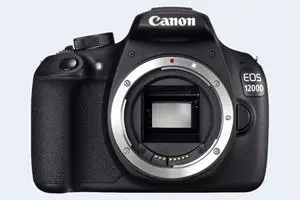Canon 1200D vs Leica D-LUX 5
The Canon EOS 1200D (called Canon T5 in some regions) and the Leica D-LUX 5 are two digital cameras that were officially introduced, respectively, in February 2014 and September 2010. The 1200D is a DSLR, while the D-LUX 5 is a fixed lens compact. The cameras are based on an APS-C (1200D) and a 1/1.7-inch (D-LUX 5) sensor. The Canon has a resolution of 17.9 megapixels, whereas the Leica provides 10 MP.
Below is an overview of the main specs of the two cameras as a starting point for the comparison.

Check 1200D offers at
ebay.com

Check D-LUX 5 offers at
ebay.com
Going beyond this snapshot of core features and characteristics, what are the differences between the Canon EOS 1200D and the Leica D-LUX 5? Which one should you buy? Read on to find out how these two cameras compare with respect to their body size, their imaging sensors, their shooting features, their input-output connections, and their reception by expert reviewers.
Body comparison
An illustration of the physical size and weight of the Canon 1200D and the Leica D-LUX 5 is provided in the side-by-side display below. The two cameras are presented according to their relative size. Three consecutive perspectives from the front, the top, and the back are available. All size dimensions are rounded to the nearest millimeter.
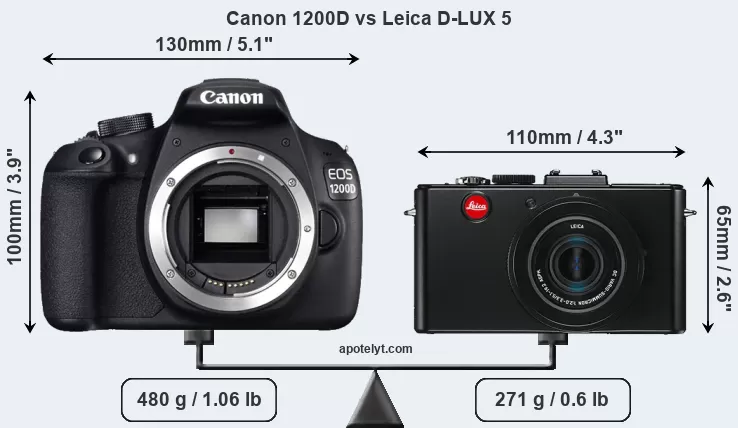
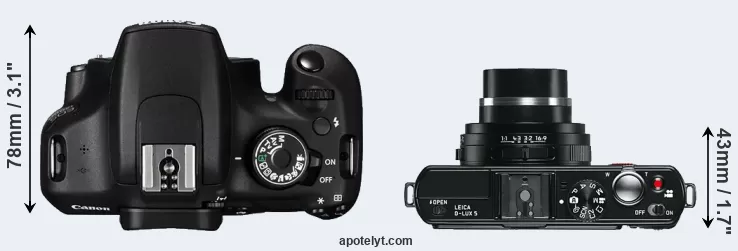
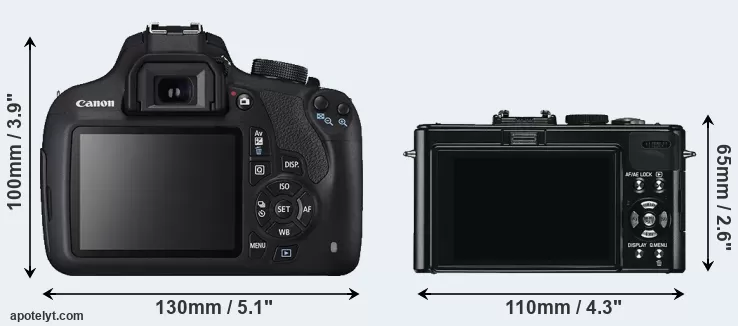
If the front view area (width x height) of the cameras is taken as an aggregate measure of their size, the Leica D-LUX 5 is considerably smaller (45 percent) than the Canon 1200D. In this context, it is worth noting that neither the 1200D nor the D-LUX 5 are weather-sealed.
The above size and weight comparisons are to some extent incomplete and possibly misleading, as the D-LUX 5 has a lens built in, whereas the 1200D is an interchangeable lens camera that requires a separate lens. Attaching the latter will add extra weight and bulk to the setup. You can compare the optics available for the 1200D and their specifications in the Canon EF Lens Catalog.
Concerning battery life, the 1200D gets 500 shots out of its Canon LP-E10 battery, while the D-LUX 5 can take 400 images on a single charge of its Leica BP-DC10 power pack.
The following table provides a synthesis of the main physical specifications of the two cameras and other similar ones. If you want to switch the focus of the display and review another camera pair, you can move across to the CAM-parator tool and choose from the broad selection of possible camera comparisons there.

| Camera Model |
Camera Width |
Camera Height |
Camera Depth |
Camera Weight |
Battery Life |
Weather Sealing |
Camera Launch |
Launch Price (USD) |
Street Price |
||
|---|---|---|---|---|---|---|---|---|---|---|---|
| 1. | Canon 1200D | 130 mm | 100 mm | 78 mm | 480 g | 500 | n | Feb 2014 | 449 | ebay.com | |
| 2. | Leica D-LUX 5 | 110 mm | 65 mm | 43 mm | 271 g | 400 | n | Sep 2010 | 699 | ebay.com | |
| 3. | Canon 100D | 117 mm | 91 mm | 69 mm | 407 g | 380 | n | Mar 2013 | 549 | ebay.com | |
| 4. | Canon 650D | 133 mm | 100 mm | 79 mm | 575 g | 440 | n | Jun 2012 | 849 | ebay.com | |
| 5. | Canon 700D | 133 mm | 100 mm | 79 mm | 580 g | 440 | n | Mar 2013 | 649 | ebay.com | |
| 6. | Canon 750D | 132 mm | 101 mm | 78 mm | 555 g | 440 | n | Feb 2015 | 749 | ebay.com | |
| 7. | Canon 760D | 132 mm | 101 mm | 78 mm | 565 g | 440 | n | Feb 2015 | 649 | ebay.com | |
| 8. | Canon 1100D | 130 mm | 100 mm | 78 mm | 495 g | 700 | n | Feb 2011 | 449 | ebay.com | |
| 9. | Canon 1300D | 129 mm | 101 mm | 78 mm | 485 g | 500 | n | Mar 2016 | 449 | ebay.com | |
| 10. | Canon 4000D | 129 mm | 102 mm | 77 mm | 436 g | 500 | n | Feb 2018 | 399 | amazon.com | |
| 11. | Canon G9 X | 98 mm | 58 mm | 31 mm | 209 g | 220 | n | Oct 2015 | 529 | ebay.com | |
| 12. | Canon M10 | 108 mm | 67 mm | 35 mm | 301 g | 255 | n | Oct 2015 | 499 | ebay.com | |
| 13. | Fujifilm X10 | 117 mm | 70 mm | 57 mm | 350 g | 270 | n | Sep 2011 | 599 | ebay.com | |
| 14. | Leica D-LUX 6 | 111 mm | 68 mm | 46 mm | 298 g | 330 | n | Sep 2012 | 699 | ebay.com | |
| 15. | Leica V-LUX 3 | 124 mm | 81 mm | 95 mm | 540 g | 410 | n | Dec 2011 | 949 | ebay.com | |
| 16. | Leica X1 | 124 mm | 60 mm | 32 mm | 306 g | 260 | n | Sep 2009 | 1,995 | ebay.com | |
| 17. | Panasonic LX5 | 110 mm | 65 mm | 43 mm | 271 g | 400 | n | Jul 2010 | 499 | ebay.com | |
| Note: Measurements and pricing do not include easily detachable parts, such as add-on or interchangeable lenses or optional viewfinders. | |||||||||||
Any camera decision will naturally be influenced heavily by the price. The manufacturer’s suggested retail prices give an idea on the placement of the camera in the maker’s lineup and the broader market. Usually, retail prices stay at first close to the launch price, but after several months, discounts become available. Later in the product cycle and, in particular, when the replacement model is about to appear, further discounting and stock clearance sales often push the camera price considerably down. Then, after the new model is out, very good deals can frequently be found on the pre-owned market.
Sensor comparison
The imaging sensor is at the core of digital cameras and its size is one of the main determining factors of image quality. A large sensor will tend to have larger individual pixels that provide better low-light sensitivity, wider dynamic range, and richer color-depth than smaller pixel-units in a sensor of the same technological generation. Furthermore, a large sensor camera will give the photographer more possibilities to use shallow depth-of-field in order to isolate a subject from the background. On the downside, larger sensors tend to be more expensive and lead to bigger and heavier cameras and lenses.
Of the two cameras under consideration, the Canon 1200D features an APS-C sensor and the Leica D-LUX 5 a 1/1.7-inch sensor. The sensor area in the D-LUX 5 is 86 percent smaller. As a result of these sensor size differences, the cameras have a format factor of, respectively, 1.6 and 4.4. The sensor in the 1200D has a native 3:2 aspect ratio, while the one in the D-LUX 5 offers a 4:3 aspect. The D-LUX 5 has the particularity of featuring a switch that allows to toggle between multiple aspect ratios, while maintaining the same field of view and full image resolution.
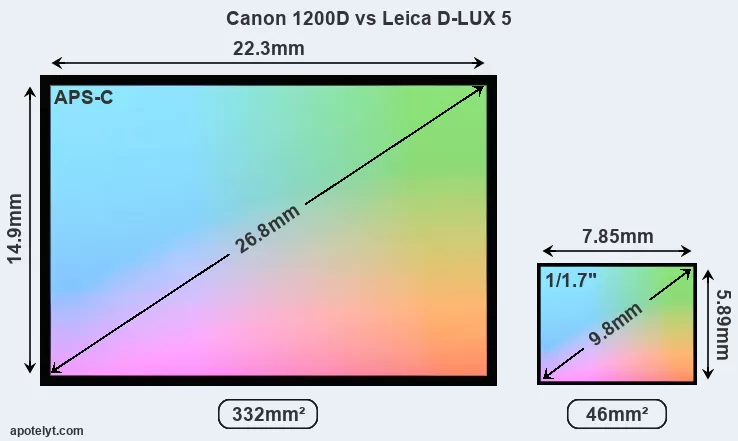
With 17.9MP, the 1200D offers a higher resolution than the D-LUX 5 (10MP), but the 1200D nevertheless has larger individual pixels (pixel pitch of 4.31μm versus 2.14μm for the D-LUX 5) due to its larger sensor. Moreover, the 1200D is a much more recent model (by 3 years and 4 months) than the D-LUX 5, and its sensor will have benefitted from technological advances during this time that further enhance the light gathering capacity of its pixels.
The resolution advantage of the Canon 1200D implies greater flexibility for cropping images or the possibility to print larger pictures. The maximum print size of the 1200D for good quality output (200 dots per inch) amounts to 25.9 x 17.3 inches or 65.8 x 43.9 cm, for very good quality (250 dpi) 20.7 x 13.8 inches or 52.7 x 35.1 cm, and for excellent quality (300 dpi) 17.3 x 11.5 inches or 43.9 x 29.3 cm. The corresponding values for the Leica D-LUX 5 are 18.2 x 13.7 inches or 46.3 x 34.7 cm for good quality, 14.6 x 10.9 inches or 37.1 x 27.8 cm for very good quality, and 12.2 x 9.1 inches or 30.9 x 23.2 cm for excellent quality prints.
The Canon EOS 1200D has a native sensitivity range from ISO 100 to ISO 6400, which can be extended to ISO 100-12800. The corresponding ISO settings for the Leica D-LUX 5 are ISO 80 to ISO 3200, with the possibility to increase the ISO range to 80-12800.
In terms of underlying technology, the 1200D is build around a CMOS sensor, while the D-LUX 5 uses a CCD imager. Both cameras use a Bayer filter for capturing RGB colors on a square grid of photosensors. This arrangement is found in most digital cameras.
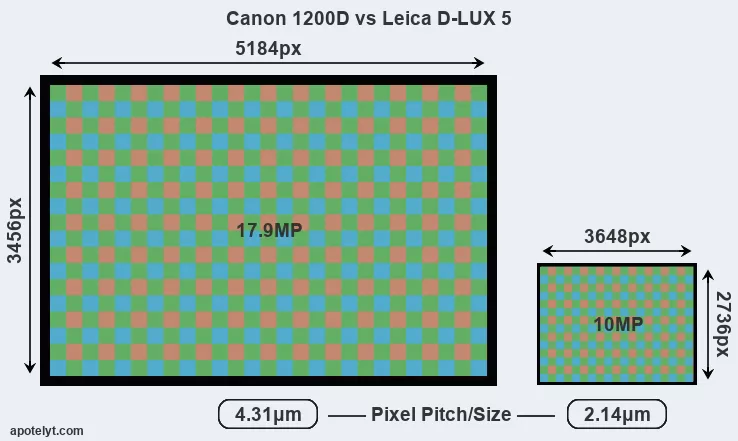
For many cameras, data on sensor performance has been reported by DXO Mark. This service determines an overall sensor rating, as well as sub-scores for low-light sensitivity ("DXO Sports"), dynamic range ("DXO Landscape"), and color depth ("DXO Portrait"). The table below summarizes the physical sensor characteristics and sensor quality findings and compares them across a set of similar cameras.

| Camera Model |
Sensor Class |
Resolution (MP) |
Horiz. Pixels |
Vert. Pixels |
Video Format |
DXO Portrait |
DXO Landscape |
DXO Sports |
DXO Overall |
||
|---|---|---|---|---|---|---|---|---|---|---|---|
| 1. | Canon 1200D | APS-C | 17.9 | 5184 | 3456 | 1080/30p | 21.9 | 11.3 | 724 | 63 | |
| 2. | Leica D-LUX 5 | 1/1.7 | 10.0 | 3648 | 2736 | 720/60p | 19.5 | 10.4 | -583 | 39 | |
| 3. | Canon 100D | APS-C | 17.9 | 5184 | 3456 | 1080/30p | 21.8 | 11.3 | 843 | 63 | |
| 4. | Canon 650D | APS-C | 17.9 | 5184 | 3456 | 1080/30p | 21.7 | 11.2 | 722 | 62 | |
| 5. | Canon 700D | APS-C | 17.9 | 5184 | 3456 | 1080/30p | 21.7 | 11.2 | 681 | 61 | |
| 6. | Canon 750D | APS-C | 24.0 | 6000 | 4000 | 1080/30p | 22.7 | 12.0 | 919 | 71 | |
| 7. | Canon 760D | APS-C | 24.0 | 6000 | 4000 | 1080/30p | 22.6 | 12.0 | 915 | 70 | |
| 8. | Canon 1100D | APS-C | 12.2 | 4272 | 2848 | 720/30p | 21.9 | 11.0 | 755 | 62 | |
| 9. | Canon 1300D | APS-C | 17.9 | 5184 | 3456 | 1080/30p | 22.0 | 11.7 | 781 | 66 | |
| 10. | Canon 4000D | APS-C | 17.9 | 5184 | 3456 | 1080/30p | 21.9 | 11.4 | 695 | 63 | |
| 11. | Canon G9 X | 1-inch | 20.0 | 5472 | 3648 | 1080/60p | 21.5 | 12.3 | 495 | 63 | |
| 12. | Canon M10 | APS-C | 17.9 | 5184 | 3456 | 1080/30p | 22.2 | 11.4 | 753 | 65 | |
| 13. | Fujifilm X10 | 2/3 | 12.0 | 4000 | 3000 | 1080/30p | 20.5 | 11.3 | 245 | 50 | |
| 14. | Leica D-LUX 6 | 1/1.7 | 10.0 | 3648 | 2736 | 1080/60p | 19.8 | 10.8 | -303 | 43 | |
| 15. | Leica V-LUX 3 | 1/2.3 | 12.0 | 4000 | 3000 | 1080/60p | 19.7 | 11.0 | 430 | 42 | |
| 16. | Leica X1 | APS-C | 12.2 | 4272 | 2856 | none | 22.6 | 11.8 | 1037 | 69 | |
| 17. | Panasonic LX5 | 1/1.7 | 10.0 | 3648 | 2736 | 720/60p | 19.6 | 10.8 | 132 | 41 | |
| Note: DXO values in italics represent estimates based on sensor size and age. | |||||||||||
Many modern cameras are not only capable of taking still images, but also of capturing video footage. The two cameras under consideration both have sensors whose read-out speed is fast enough to capture moving pictures, but the 1200D provides a higher video resolution than the D-LUX 5. It can shoot video footage at 1080/30p, while the Leica is limited to 720/60p.
Feature comparison
Apart from body and sensor, cameras can and do differ across a range of features. For example, the 1200D has an optical viewfinder, which can be very useful when shooting in bright sunlight. In contrast, the D-LUX 5 relies on live view and the rear LCD for framing. That said, the D-LUX 5 can be equipped with an optional viewfinder – the EVF1. The adjacent table lists some of the other core features of the Canon 1200D and Leica D-LUX 5 along with similar information for a selection of comparators.

| Camera Model |
Viewfinder (Type or 000 dots) |
Control Panel (yes/no) |
LCD Specifications (inch/000 dots) |
LCD Attach- ment |
Touch Screen (yes/no) |
Max Shutter Speed * |
Max Shutter Flaps * |
Built-in Flash (yes/no) |
Built-in Image Stab |
||
|---|---|---|---|---|---|---|---|---|---|---|---|
| 1. | Canon 1200D | optical | n | 3.0 / 460 | fixed | n | 1/4000s | 3.0/s | Y | n | |
| 2. | Leica D-LUX 5 | optional | n | 3.0 / 460 | fixed | n | 1/4000s | 2.5/s | Y | Y | |
| 3. | Canon 100D | optical | n | 3.0 / 1040 | fixed | Y | 1/4000s | 4.9/s | Y | n | |
| 4. | Canon 650D | optical | n | 3.0 / 1040 | swivel | Y | 1/4000s | 5.0/s | Y | n | |
| 5. | Canon 700D | optical | n | 3.0 / 1040 | swivel | Y | 1/4000s | 5.0/s | Y | n | |
| 6. | Canon 750D | optical | n | 3.0 / 1040 | swivel | Y | 1/4000s | 5.0/s | Y | n | |
| 7. | Canon 760D | optical | Y | 3.0 / 1040 | swivel | Y | 1/4000s | 5.0/s | Y | n | |
| 8. | Canon 1100D | optical | n | 2.7 / 230 | fixed | n | 1/4000s | 3.0/s | Y | n | |
| 9. | Canon 1300D | optical | n | 3.0 / 920 | fixed | n | 1/4000s | 3.0/s | Y | n | |
| 10. | Canon 4000D | optical | n | 2.7 / 230 | fixed | n | 1/4000s | 3.0/s | Y | n | |
| 11. | Canon G9 X | none | n | 3.0 / 1040 | fixed | Y | 1/2000s | 6.0/s | Y | Y | |
| 12. | Canon M10 | none | n | 3.0 / 1040 | tilting | Y | 1/4000s | 4.6/s | Y | n | |
| 13. | Fujifilm X10 | optical | n | 2.8 / 460 | fixed | n | 1/4000s | 10.0/s | Y | Y | |
| 14. | Leica D-LUX 6 | optional | n | 3.0 / 920 | fixed | n | 1/4000s | 11.0/s | Y | Y | |
| 15. | Leica V-LUX 3 | 202 | n | 3.0 / 460 | swivel | n | 1/2000s | 12.0/s | Y | Y | |
| 16. | Leica X1 | none | n | 2.7 / 230 | fixed | n | 1/2000s | 3.0/s | Y | n | |
| 17. | Panasonic LX5 | optional | n | 3.0 / 460 | fixed | n | 1/4000s | 2.5/s | Y | Y | |
| Note: *) Information refers to the mechanical shutter, unless the camera only has an electronic one. | |||||||||||
Concerning the storage of imaging data, both the 1200D and the D-LUX 5 write their files to SDXC cards.
Connectivity comparison
For some imaging applications, the extent to which a camera can communicate with its environment can be an important aspect in the camera decision process. The table below provides an overview of the connectivity of the Canon EOS 1200D and Leica D-LUX 5 and, in particular, the interfaces the cameras (and selected comparators) provide for accessory control and data transfer.

| Camera Model |
Hotshoe Port |
Internal Mic / Speaker |
Microphone Port |
Headphone Port |
HDMI Port |
USB Port |
WiFi Support |
NFC Support |
Bluetooth Support |
||
|---|---|---|---|---|---|---|---|---|---|---|---|
| 1. | Canon 1200D | Y | mono / mono | - | - | mini | 2.0 | - | - | - | |
| 2. | Leica D-LUX 5 | Y | mono / mono | - | - | mini | 2.0 | - | - | - | |
| 3. | Canon 100D | Y | mono / mono | Y | - | mini | 2.0 | - | - | - | |
| 4. | Canon 650D | Y | stereo / mono | Y | - | mini | 2.0 | - | - | - | |
| 5. | Canon 700D | Y | stereo / mono | Y | - | mini | 2.0 | - | - | - | |
| 6. | Canon 750D | Y | stereo / mono | Y | - | mini | 2.0 | Y | Y | - | |
| 7. | Canon 760D | Y | stereo / mono | Y | - | mini | 2.0 | Y | Y | - | |
| 8. | Canon 1100D | Y | stereo / mono | - | - | mini | 2.0 | - | - | - | |
| 9. | Canon 1300D | Y | mono / mono | - | - | mini | 2.0 | Y | Y | - | |
| 10. | Canon 4000D | Y | mono / mono | - | - | mini | 2.0 | Y | Y | - | |
| 11. | Canon G9 X | - | stereo / mono | - | - | micro | 2.0 | Y | Y | - | |
| 12. | Canon M10 | - | stereo / mono | - | - | mini | 2.0 | Y | Y | - | |
| 13. | Fujifilm X10 | Y | stereo / mono | - | - | mini | 2.0 | - | - | - | |
| 14. | Leica D-LUX 6 | Y | stereo / mono | - | - | mini | 2.0 | - | - | - | |
| 15. | Leica V-LUX 3 | Y | stereo / - | - | - | mini | 2.0 | - | - | - | |
| 16. | Leica X1 | Y | - / - | - | - | mini | 2.0 | - | - | - | |
| 17. | Panasonic LX5 | Y | mono / mono | - | - | mini | 2.0 | - | - | - |
Both the 1200D and the D-LUX 5 have been discontinued, but can regularly be found used on ebay. The D-LUX 5 was replaced by the Leica D-LUX 6, while the 1200D was followed by the Canon 1300D. Further information on the features and operation of the 1200D and D-LUX 5 can be found, respectively, in the Canon 1200D Manual (free pdf) or the online Leica D-LUX 5 Manual.
Review summary
So what is the bottom line? Is the Canon 1200D better than the Leica D-LUX 5 or vice versa? Below is a summary of the relative strengths of each of the two contestants.

Arguments in favor of the Canon EOS 1200D:
- More detail: Offers more megapixels (17.9 vs 10MP) with a 37% higher linear resolution.
- Better image quality: Features a larger and more technologically advanced imaging sensor.
- Richer colors: The sensor size advantage translates into images with better, more accurate colors.
- More dynamic range: Larger sensor captures a wider spectrum of light and dark details.
- Better low-light sensitivity: Larger sensor produces good images even in poorly lit environments.
- Better video: Provides higher definition movie capture (1080/30p vs 720/60p).
- Easier framing: Has an optical viewfinder for image composition and settings control.
- Faster burst: Shoots at higher frequency (3 vs 2.5 flaps/sec) to capture the decisive moment.
- More flexible: Can take a variety of interchangeable lenses, including specialty optics.
- Longer lasting: Can take more shots (500 versus 400) on a single battery charge.
- More modern: Reflects 3 years and 4 months of technical progress since the D-LUX 5 launch.

Advantages of the Leica D-LUX 5:
- Flexible image proportions: Has a multi-aspect sensor that allows for alternative image shapes.
- Ready to shoot: Comes with an integrated lens, while the 1200D requires a separate lens.
- More compact: Is smaller (110x65mm vs 130x100mm) and will fit more readily into a bag.
- Less heavy: Has a lower weight even though it has a lens built in (unlike the 1200D).
- Sharper images: Has stabilization technology built-in to reduce the impact of hand-shake.
- More prestigious: Has the Leica luxury appeal, which ensures a high resale value.
- More heavily discounted: Has been around for much longer (launched in September 2010).
If the number of relative strengths (bullet points above) is taken as a guide, the 1200D is the clear winner of the match-up (11 : 7 points). However, the relevance of individual strengths will vary across photographers, so that you might want to apply your own weighing scheme to the summary points when reflecting and deciding on a new camera. A professional wildlife photographer will view the differences between cameras in a way that diverges from the perspective of a family photog, and a person interested in architecture has distinct needs from a sports shooter. Hence, the decision which camera is best and worth buying is often a very personal one.
How about other alternatives? Do the specifications of the Canon 1200D and the Leica D-LUX 5 place the cameras among the top in their class? Find out in the latest Best DSLR Camera and Best Travel-Zoom Camera listings whether the two cameras rank among the cream of the crop.
In any case, while the specs-based evaluation of cameras can be instructive in revealing their potential as photographic tools, it remains incomplete and does no justice, for example, to the way the 1200D or the D-LUX 5 perform in practice. User reviews that are available, for instance, at amazon can sometimes shed light on these issues, but such feedback is all too often partial, inconsistent, and inaccurate.
Expert reviews
This is why expert reviews are important. The adjacent summary-table relays the overall verdicts of several of the most popular camera review sites (amateurphotographer [AP], cameralabs [CL], digitalcameraworld [DCW], dpreview [DPR], ephotozine [EPZ], photographyblog [PB]). As can be seen, the professional reviewers agree in many cases on the quality of different cameras, but sometimes their assessments diverge, reinforcing the earlier point that a camera decision is often a very personal choice.

| Camera Model |
AP score |
CL score |
DCW score |
DPR score |
EPZ score |
PB score |
Camera Launch |
Launch Price (USD) |
Street Price |
||
|---|---|---|---|---|---|---|---|---|---|---|---|
| 1. | Canon 1200D | 3/5 | + | .. | .. | 4/5 | 4.5/5 | Feb 2014 | 449 | ebay.com | |
| 2. | Leica D-LUX 5 | .. | .. | .. | .. | 4.5/5 | 4/5 | Sep 2010 | 699 | ebay.com | |
| 3. | Canon 100D | 4/5 | + | .. | 78/100 | 4/5 | 4/5 | Mar 2013 | 549 | ebay.com | |
| 4. | Canon 650D | 4/5 | + + | .. | 77/100 | 4.5/5 | 4.5/5 | Jun 2012 | 849 | ebay.com | |
| 5. | Canon 700D | .. | .. | .. | 76/100 | 4.5/5 | 4.5/5 | Mar 2013 | 649 | ebay.com | |
| 6. | Canon 750D | 5/5 | .. | .. | 75/100 | 4.5/5 | 4.5/5 | Feb 2015 | 749 | ebay.com | |
| 7. | Canon 760D | 5/5 | + | .. | 77/100 | 4.5/5 | 4.5/5 | Feb 2015 | 649 | ebay.com | |
| 8. | Canon 1100D | .. | 80/100 | .. | 69/100 | 4/5 | 4.5/5 | Feb 2011 | 449 | ebay.com | |
| 9. | Canon 1300D | 4/5 | o | 4/5 | 73/100 | 4/5 | 4/5 | Mar 2016 | 449 | ebay.com | |
| 10. | Canon 4000D | 2.5/5 | o | 3/5 | .. | 3.5/5 | 3.5/5 | Feb 2018 | 399 | amazon.com | |
| 11. | Canon G9 X | 3.5/5 | + + | .. | .. | 4.5/5 | 4.5/5 | Oct 2015 | 529 | ebay.com | |
| 12. | Canon M10 | .. | .. | .. | .. | .. | 4/5 | Oct 2015 | 499 | ebay.com | |
| 13. | Fujifilm X10 | .. | .. | .. | 76/100 | 4/5 | 4.5/5 | Sep 2011 | 599 | ebay.com | |
| 14. | Leica D-LUX 6 | .. | .. | .. | .. | 4/5 | 4/5 | Sep 2012 | 699 | ebay.com | |
| 15. | Leica V-LUX 3 | .. | .. | .. | .. | .. | .. | Dec 2011 | 949 | ebay.com | |
| 16. | Leica X1 | 3/5 | .. | .. | + | .. | 4/5 | Sep 2009 | 1,995 | ebay.com | |
| 17. | Panasonic LX5 | 4/5 | + | .. | 73/100 | 4.5/5 | 4.5/5 | Jul 2010 | 499 | ebay.com | |
| Note: (+ +) highly recommended; (+) recommended; (o) reviewed; (..) not available. | |||||||||||
The review scores listed above should be treated with care, though. The ratings were established in reference to similarly priced cameras that were available in the market at the time of the review. A score, therefore, has to be seen in close connection to the price and market introduction time of the camera, and comparing ratings of very distinct cameras or ones that are far apart in terms of their release date have little meaning. Also, please note that some of the review sites have changed their methodology and reporting over time.

Check 1200D offers at
ebay.com

Check D-LUX 5 offers at
ebay.com
Other camera comparisons
Did this review help to inform your camera decision process? If you would like to see a different side-by-side camera review, just make a corresponding selection in the search boxes below. As an alternative, you can also directly jump to any one of the listed comparisons that were previously generated by the CAM-parator tool.
- Canon 1200D vs Canon 1D X
- Canon 1200D vs Fujifilm X-T3
- Canon 1200D vs Nikon D5300
- Canon 1200D vs Olympus E-P2
- Canon 1200D vs Olympus E-P5
- Canon 1200D vs Panasonic TZ95
- Canon 650D vs Leica D-LUX 5
- Canon M100 vs Leica D-LUX 5
- Canon SX720 vs Leica D-LUX 5
- Leica D-LUX 5 vs Leica S Typ 006
- Leica D-LUX 5 vs Nikon D60
- Leica D-LUX 5 vs Pentax K-1
Specifications: Canon 1200D vs Leica D-LUX 5
Below is a side-by-side comparison of the specs of the two cameras to facilitate a quick review of their differences and common features.
| Camera Model | Canon 1200D | Leica D-LUX 5 |
|---|---|---|
| Camera Type | Digital single lens reflex | Fixed lens compact camera |
| Camera Lens | Canon EF mount lenses | 24-90mm f/2.0-3.3 |
| Launch Date | February 2014 | September 2010 |
| Launch Price | USD 449 | USD 699 |
| Sensor Specs | Canon 1200D | Leica D-LUX 5 |
| Sensor Technology | CMOS | CCD |
| Sensor Format | APS-C Sensor | 1/1.7" Sensor |
| Sensor Size | 22.3 x 14.9 mm | 7.85 x 5.89 mm |
| Sensor Area | 332.27 mm2 | 46.2365 mm2 |
| Sensor Diagonal | 26.8 mm | 9.8 mm |
| Crop Factor | 1.6x | 4.4x |
| Sensor Resolution | 17.9 Megapixels | 10 Megapixels |
| Image Resolution | 5184 x 3456 pixels | 3648 x 2736 pixels |
| Pixel Pitch | 4.31 μm | 2.14 μm |
| Pixel Density | 5.39 MP/cm2 | 21.59 MP/cm2 |
| Moiré control | Anti-Alias filter | Anti-Alias filter |
| Movie Capability | 1080/30p Video | 720/60p Video |
| ISO Setting | 100 - 6,400 ISO | 80 - 3,200 ISO |
| ISO Boost | 100 - 12,800 ISO | 80 - 12,800 ISO |
| DXO Sensor Quality (score) | 63 | .. |
| DXO Color Depth (bits) | 21.9 | .. |
| DXO Dynamic Range (EV) | 11.3 | .. |
| DXO Low Light (ISO) | 724 | .. |
| Screen Specs | Canon 1200D | Leica D-LUX 5 |
| Viewfinder Type | Optical viewfinder | Viewfinder optional |
| Viewfinder Field of View | 95% | |
| Viewfinder Magnification | 0.50x | |
| LCD Framing | Live View | Live View |
| Rear LCD Size | 3.0inch | 3.0inch |
| LCD Resolution | 460k dots | 460k dots |
| LCD Attachment | Fixed screen | Fixed screen |
| Shooting Specs | Canon 1200D | Leica D-LUX 5 |
| Focus System | Phase-detect AF | Contrast-detect AF |
| Continuous Shooting | 3 shutter flaps/s | 2.5 shutter flaps/s |
| Fill Flash | Built-in Flash | Built-in Flash |
| Storage Medium | SDXC cards | SDXC cards |
| Single or Dual Card Slots | Single card slot | Single card slot |
| UHS card support | no | no |
| Connectivity Specs | Canon 1200D | Leica D-LUX 5 |
| External Flash | Hotshoe | Hotshoe |
| USB Connector | USB 2.0 | USB 2.0 |
| HDMI Port | mini HDMI | mini HDMI |
| Wifi Support | no Wifi | no Wifi |
| Body Specs | Canon 1200D | Leica D-LUX 5 |
| Battery Type | Canon LP-E10 | Leica BP-DC10 |
| Battery Life (CIPA) | 500 shots per charge | 400 shots per charge |
| Body Dimensions |
130 x 100 x 78 mm (5.1 x 3.9 x 3.1 in) |
110 x 65 x 43 mm (4.3 x 2.6 x 1.7 in) |
| Camera Weight | 480 g (16.9 oz) | 271 g (9.6 oz) |

Check 1200D offers at
ebay.com

Check D-LUX 5 offers at
ebay.com
Did you notice an error on this page? If so, please get in touch, so that we can correct the information.
